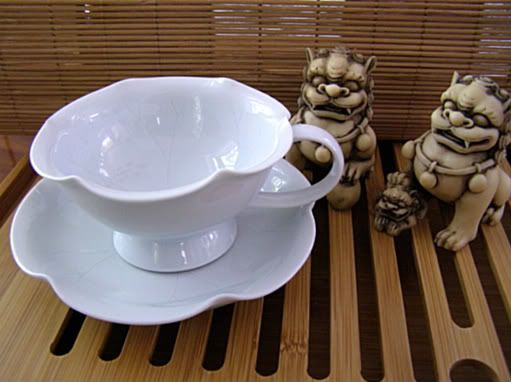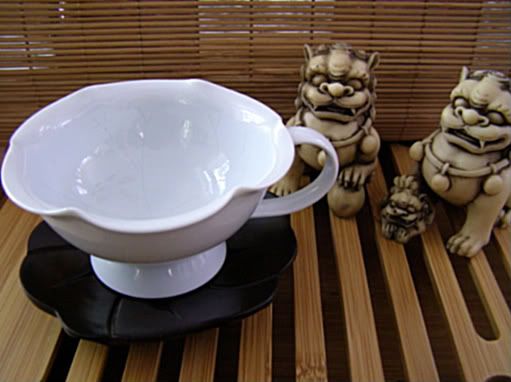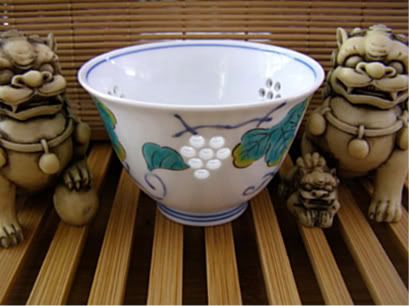leiche, the chawan was an ebay purchase. I have been wanting a Kyoyaki bowl for a while and when I saw that one...I knew that was it.
Sal, I got the tatami mat at Ziji It was a little expensive but I had a hard time tracking one down. If you live near Daiso, I hear you can get them there cheap.
Sal, I got the tatami mat at Ziji It was a little expensive but I had a hard time tracking one down. If you live near Daiso, I hear you can get them there cheap.
Sep 24th, '08, 11:08
Posts: 1953
Joined: Apr 6th, '08, 19:02
Location: British Columbia, Canada
Contact:
chamekke
Sweet!Buzz Fledderjohn wrote:
Buzz, did the eBay listing identify the design at the bottom of the cup? It looks very much to me like kicho - a kind of cloth room-curtain, often highly decorated, that originated in the Heian period. Kicho curtains often appear as motifs on kimono and obi as well. See here and here for more on kicho.
Sep 24th, '08, 22:09
Posts: 1953
Joined: Apr 6th, '08, 19:02
Location: British Columbia, Canada
Contact:
chamekke
Sep 24th, '08, 23:51
Posts: 1953
Joined: Apr 6th, '08, 19:02
Location: British Columbia, Canada
Contact:
chamekke
Dear Betta,betta wrote:
It has a special geometry and description in Japanese which I can't read. Clerk said it could bring the best aroma of a sochu and tea brewed in it, which I haven't confirmed.
Could anyone here help me with the translation?
My friend got back to me with the translation tonight. Actually, she walked through it in somewhat rapid-fire English, and my transcription of it is a bit garbled as a result. Anyway, I will just give you my transcription as I typed it out - admittedly I may have missed a couple of things here and there, but I think this covers the gist of it.
First of all, apparently the vessel is meant primarily as a sake cup (sakazuki) or cup for alcohol, rather than a cup for tea. Probably it can serve as both, but the "five special features" seem oriented mainly towards sake, and chilled sake at that. (I'm not sure, but I think "sochu" should be transliterated as shouchuu [焼酎], a type of liquor distilled from grain.)
1 - Aroma - It has design that having cup's original "R" aroma rises alongside the side of the cup rim. The cup has been designed for the aroma of the sake to rise alongside the rim. (My friend said that the "R" part was in katakana script and she doesn't know what it means; perhaps it's a trade name.)
2 - Ice cubes - for drinks - normally 6cm ice cubes will go through easily from the top to the bottom - also when the ice cube goes in, the cube will roll and make a rolling sound. The cup has been designed for that - the sides and bottom. When you drink sake, the ice cubes roll inside the cup and make a nice rolling sound (korokoro = clink clink).
3 - Taste or savour - making sake cup mouth narrow, you feel smooth surface of sake cup and in that way you can enjoy the length of the sake savour/taste and the touch of your tongue is very smooth.
4 - Size - the size is made for the inside of your hand, palm, it stays naturally with balance and is easy to hold. This is why they made it that size - it's made to the size/shape so that it rests in the palm of the hand, securely and with balance.
5 - Three hind legs - coaster attaches to sake cup by a drop of water at the same time the cup - the legs are made for the sake cup so that the cup doesn't get stuck to the coaster. That is why they designed it that way. (I checked with my friend, and this seems to mean that when you use a flat-bottomed cup with a chataku or saucer, sometimes the saucer sticks to the bottom of the cup because of condensation - a problem that does not arise thanks to the three legs on the bottom of this cup.)
These are the five characteristics of this sake cup.
______________________
"Never trust a man who, when left alone in a room with a tea cosy, doesn't try it on."
- Billy Connolly
"Never trust a man who, when left alone in a room with a tea cosy, doesn't try it on."
- Billy Connolly







